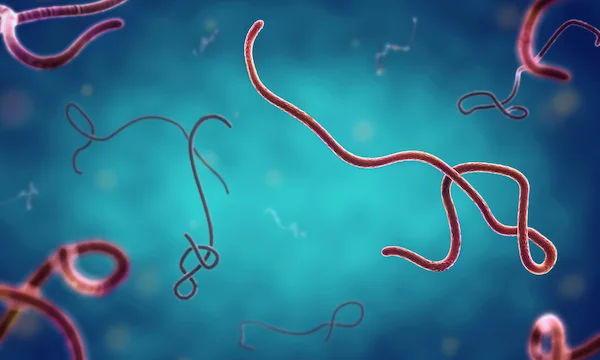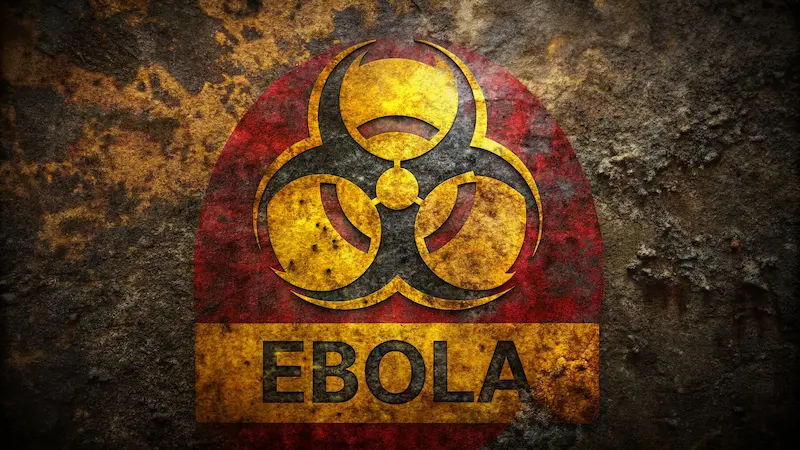Ebola Virus: Symptoms, Treatment, and Prevention
Learn about the Ebola virus, its symptoms, available treatments, and prevention measures to protect yourself and others from infection.

Written by Dr. J T Hema Pratima
Reviewed by Dr. Dhankecha Mayank Dineshbhai MBBS
Last updated on 19th Dec, 2025

Introduction
The mere mention of the Ebola virus often conjures images of headlines describing a severe and frightening disease. While Ebola virus disease (EVD) is a serious, often fatal illness, understanding its facts is the first step toward demystifying it and implementing effective prevention. This virus, which causes a hemorrhagic fever, poses a significant health risk in certain parts of the world, primarily through human-to-human transmission. This comprehensive guide will walk you through everything you need to know about Ebola: from its origins and symptoms to how it spreads, and most importantly, the latest advancements in treatment and prevention. Whether you're a concerned traveller, a healthcare professional, or simply seeking knowledge, this article provides clear, evidence-based information to address your concerns and questions about this formidable pathogen.
What is the Ebola Virus?
The Ebola virus is a rare but severe, often fatal disease in humans and nonhuman primates like monkeys and gorillas. It belongs to the family Filoviridae and is known for causing viral hemorrhagic fever, which can lead to internal bleeding and organ failure. There are six known species of the virus, with four of them (Zaire, Sudan, Taï Forest, and Bundibugyo) known to cause disease in humans. The Zaire ebolavirus is the most deadly, with the highest fatality rates.
The virus was first identified in 1976 near the Ebola River in what is now the Democratic Republic of Congo. Since then, outbreaks have occurred sporadically in several African countries.
A Brief History of Ebola Outbreaks
The history of Ebola is marked by intermittent outbreaks, primarily in remote villages in Central and West Africa near tropical rainforests. The 2014-2016 outbreak in West Africa was the largest and most complex in history, primarily affecting Guinea, Sierra Leone, and Liberia, with cases spreading to other countries, including the United States and Europe. This outbreak highlighted the critical importance of global health security and accelerated the development of vaccines and treatments. More recent outbreaks in the Democratic Republic of Congo have demonstrated that while challenges remain, the world is now better equipped with tools to fight the disease.
Consult an Infectious Disease Specialist for the best advice
How Does the Ebola Virus Spread?
Understanding the transmission of Ebola is crucial for prevention and dispelling unnecessary fear. The virus is not as easily transmitted as the common cold or flu.
Primary Modes of Transmission
Ebola spreads through direct contact with the blood, secretions, organs, or other bodily fluids of infected people or animals. This typically happens through:
Broken skin or mucous membranes: The virus can enter the body through cuts, abrasions, or the eyes, nose, or mouth.
Handling infected animals: The natural host is thought to be fruit bats, and the virus can spread to humans through contact with infected wildlife (e.g., chimpanzees, gorillas, forest antelope).
Contaminated surfaces and materials: Bedding, clothing, and medical equipment soiled with an infected person's fluids can carry the virus.
Burial ceremonies: Traditions involving washing and touching the body of someone who died from EVD have been a significant source of transmission.
Importantly, people are only contagious once they start showing symptoms of Ebola virus disease.
How Ebola Does NOT Spread (Debunking Myths)
A key point of public education is clarifying how Ebola is not transmitted. It is not an airborne virus. You cannot get Ebola through:
The air (from coughing or sneezing).
Water.
Food, unless it is bushmeat from an infected animal.
Mosquitoes or other insects.
Casual contact with an asymptomatic person (someone not showing symptoms).
Recognising the Symptoms of Ebola
The incubation period, the time from infection to the onset of symptoms, ranges from 2 to 21 days. A person cannot spread the disease during this incubation period.
Early Stage Symptoms
The onset of EVD is sudden and initial signs can be easily mistaken for malaria or the flu. They include:
High fever
Severe headache
Muscle pain and joint aches
Fatigue and weakness
Sore throat
Loss of appetite
Advanced Stage Symptoms and Complications
As the disease progresses, it becomes more severe, leading to:
Nausea, vomiting, and diarrhoea (which may be bloody)
Rash
Impaired kidney and liver function
Internal and external bleeding (e.g., from gums, in stool)
Low white blood cell and platelet counts
The fatality rate for EVD averages around 50%, but has varied from 25% to 90% in past outbreaks, depending on the virus species and the quality of supportive care available. Recovery depends on good supportive clinical care and the patient’s immune response.
How is Ebola Diagnosed?
Diagnosing Ebola early is challenging because its early symptoms are nonspecific. However, it is critical for infection control. If a person has early symptoms and a potential history of exposure (e.g., recent travel to an outbreak area), they must seek medical attention immediately.
Diagnostic Tests and Procedures
Several tests can confirm an Ebola infection, but they are only effective once symptoms appear as the virus needs to reach a certain level in the blood. These include:
Antibody-capture enzyme-linked immunosorbent assay (ELISA)
Reverse transcriptase polymerase chain reaction (RT-PCR) assay
Antigen-capture detection tests
Handling patient samples poses an extreme biohazard risk and must be conducted under maximum biological containment conditions. If you are experiencing severe, unexplained symptoms and have a recent history of travel to a region with known health risks, consult a doctor online with Apollo24|7 for a preliminary risk assessment and guidance on next steps.
Ebola Virus Disease Treatment Options
There is no proven, widely available cure for Ebola. However, survival rates improve dramatically with early, professional medical intervention.
Supportive Care in a Hospital Setting
This is the cornerstone of treatment and involves:
Rehydration: Providing IV fluids and electrolytes to combat dehydration from vomiting and diarrhoea.
Oxygen therapy: Maintaining oxygen status.
Blood pressure management: Using medications to support blood pressure.
Treating other infections: Administering antibiotics or antifungals if secondary infections occur.
Pain management: Using analgesics to relieve pain.
This intensive supportive care helps the patient's body fight the virus while preventing fatal complications like organ failure.
Experimental Therapies and Antiviral Drugs
Recent outbreaks have seen the successful use of investigational treatments and drugs. These include:
Monoclonal antibodies: Drugs like Inmazeb (atoltivimab, maftivimab, and odesivimab-ebgn) and Ebanga (ansuvimab-zykl) have been approved by the FDA. They work by blocking the virus from entering human cells.
Antiviral drugs: Remdesivir (Veklury) has also shown promise in treating EVD.
These therapeutics have significantly improved survival rates for infected individuals when administered early.
Preventing Ebola Infection
Prevention is the most effective strategy against Ebola, especially in outbreak regions.
Protective Measures for Individuals and Communities
Practice good hygiene: Frequent handwashing with soap and water or using an alcohol-based hand sanitiser.
Avoid contact with blood and body fluids: Do not handle items that may have come into contact with an infected person’s fluids.
Avoid contact with bats and nonhuman primates: Avoid consumption of bushmeat.
Follow safe burial practices: Deceased bodies are still highly contagious.
Travel precautions: Stay informed about outbreaks and follow travel advisories from health authorities like the WHO and CDC.
The Role of the Ebola Vaccine
A major breakthrough in Ebola prevention is the vaccine. The Ervebo (rVSV-ZEBOV) vaccine has been highly effective in protecting against the Zaire species of the virus. It is used in a "ring vaccination" strategy, vaccinating contacts of confirmed cases and their contacts to form a protective ring. A second vaccine, Zabdeno-and-Mvabea, is also available for prevention. If you are a healthcare worker or aid worker travelling to an outbreak zone, consult with a travel medicine specialist to understand vaccination requirements and recommendations.
Life After Recovery: Post-Ebola Syndrome
Survivors of EVD can face long-term health complications, known as post-Ebola syndrome. These can include:
Chronic joint and muscle pain
Vision and eye problems (e.g., uveitis)
Fatigue
Headaches
Mental health challenges like depression and PTSD
The virus can also persist in certain body fluids of survivors (like semen, breast milk, and ocular fluid) for months after recovery, requiring ongoing medical follow-up and guidance to prevent further transmission.
Conclusion
The Ebola virus remains a formidable public health challenge, but it is no longer the mysterious and unstoppable killer it was once perceived to be. Through decades of research, we now have a deep understanding of its transmission, effective supportive care protocols that save lives, and powerful vaccines that can stop outbreaks in their tracks. The key takeaways are the importance of early detection, strict infection control practices, and the critical role of community engagement and education in prevention. While the threat of outbreaks persists, particularly in certain regions, the global health community is better prepared than ever to respond. Staying informed through authoritative sources and practicing recommended precautions are your best defenses against this rare but serious disease.
Consult an Infectious Disease Specialist for the best advice
Consult an Infectious Disease Specialist for the best advice

Dr Chilukuri Venkata Reddy
General Physician
4 Years • MBBS
Bengaluru
PRESTIGE SHANTHINIKETAN - SOCIETY CLINIC, Bengaluru
Dr Sumanth R
General Physician
2 Years • MBBS
Bengaluru
PRESTIGE SHANTHINIKETAN - SOCIETY CLINIC, Bengaluru

Dr. Thorana Prakash M
General Physician
2 Years • MBBS
Bengaluru
PRESTIGE SHANTHINIKETAN - SOCIETY CLINIC, Bengaluru

Dr. Kriti Bhat
Dermatologist
5 Years • MBBS, MD ( Dermatology, Venerology, Leprosy ) from AIIMS JODHPUR
Bengaluru
Apollo Medical Center, Marathahalli, Bengaluru

Dr Varun Panicker
General Physician/ Internal Medicine Specialist
6 Years • MBBS
Bengaluru
Apollo Clinic, JP nagar, Bengaluru
(25+ Patients)


